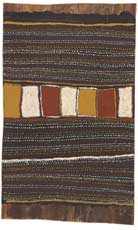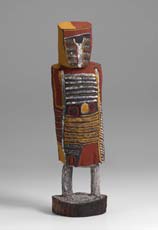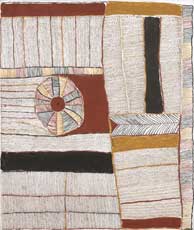
  
“I will paint until the day I die”
Kitty Kantilla (Kutuwulumi Purawarrumpatu) (Tiwi c. 1928–2003) Kitty Kantilla was one of Australia’s most remarkable Indigenous artists, celebrated for her innovation, unique style and mastery of a range of mediums. The breadth and beauty of her work will be unveiled in the major retrospective exhibition Kitty Kantilla at the Art Gallery of New South Wales. Kantilla produced an extraordinary body of work from the 1970s until her last days in 2003. In her hands the magic of Tiwi culture is translated into works of international significance. Her earliest works were tutini (grave poles) and figures carved from ironwood using only a tomahawk, chisel and mallet, bark paintings and tunga (bark baskets). Instead of using the Tiwi painting comb (pwoja), Kantilla painted with a fine stick of coconut palm frond. Her paintings featured variable dots, each bearing the mark of her inimitable hand, earning her the nickname ‘Dot Dot’. When introduced to printmaking, Kantilla relinquished dots and colour for fragile lines and bands of delicate herringbone. She experimented with ochre on paper and painted large-scale canvases, moving from the black background preferred by many Tiwi artists, to experiment with expanses of colour and white ochre over a white background. Seemingly abstract designs of Tiwi art refer to Pukumani and Kulama ceremonies and express the creativity of artists who use painting as a way of remembering. Kantilla was born at Piripumawu and grew up at Yimpinari on Melville Island, 50 kilometres north of Darwin. As a young girl, Kantilla watched her father paint his special jilamara (design) on faces, bodies and objects and experienced Pukumani ceremonies. Kantilla went on to perform her own kinship songs and dances, carving and painting tutini and painting innovative designs on the bodies of close relatives to disguise them from mapurtiti (malevolent spirits of the deceased). She began to carve for the art market in 1977 when living at Paru, an important centre of art production on Melville Island. She settled at Milikapiti in 1989, just as Jilamara Arts & Craft Association (Jilamara) was being established. Here, with support from the art centre she produced most of her work and was known as the Queen of Jilamara.
Kitty Kantilla comprises of 78 works and a major exhibition catalogue has been produced to coincide with the retrospective. Kitty Kantilla has come to the Art Gallery of New South Wales from the National Gallery of Victoria. Principal sponsor: BlueScope Steel

|